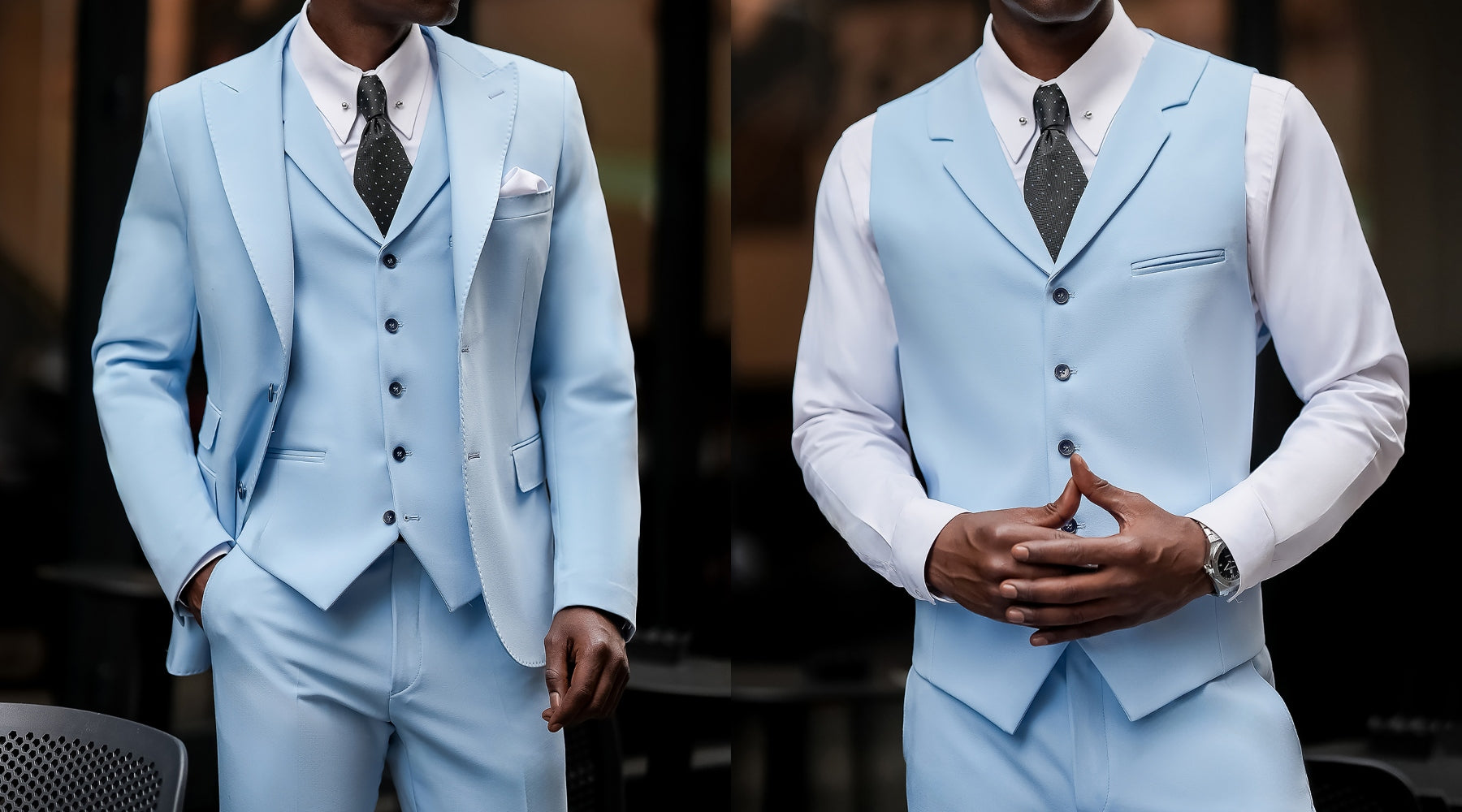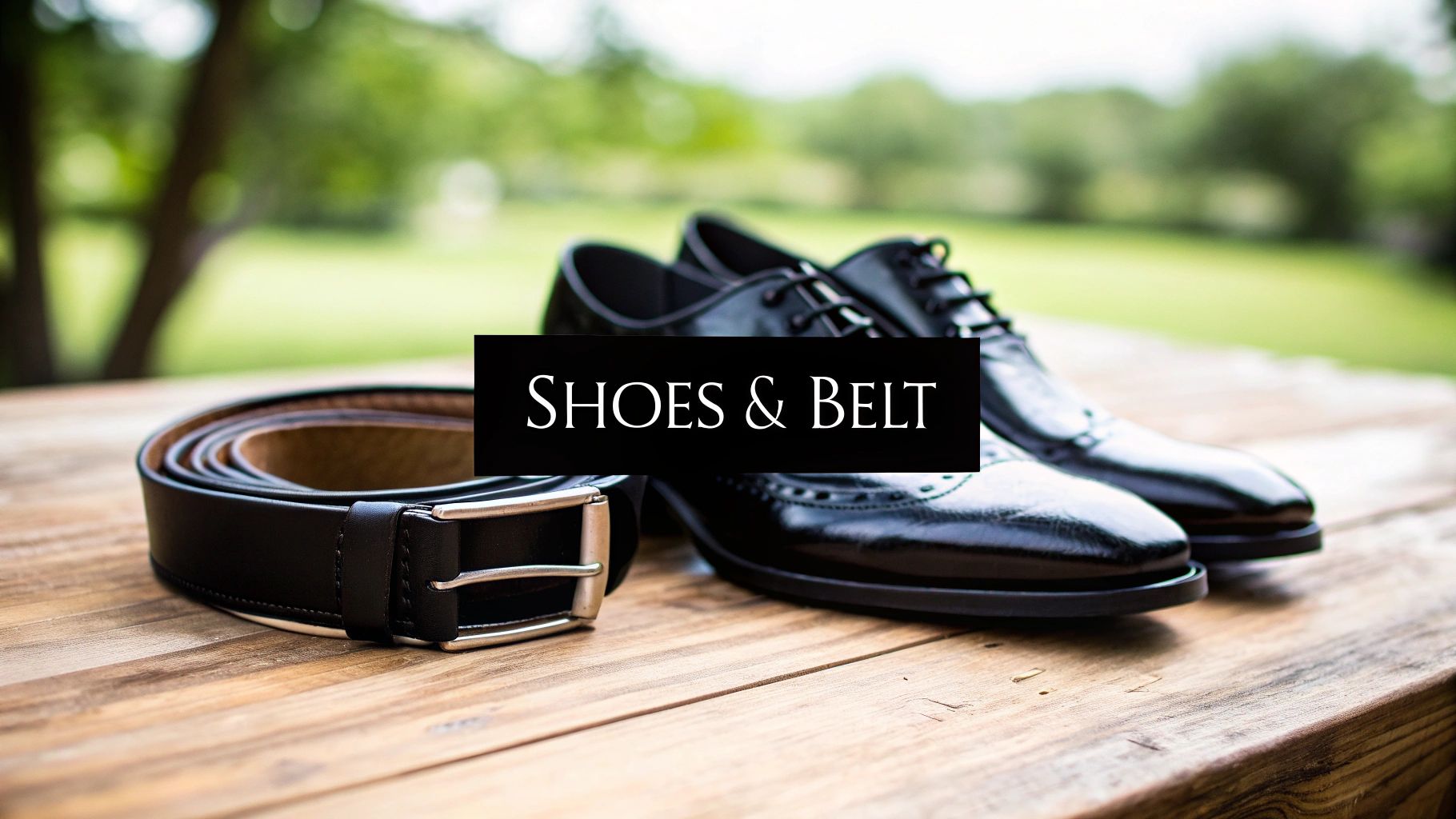
Matching Shoes and Belt: The Definitive Guide for Men's Suits and Formalwear
Absolutely. That old saying about matching your shoes to your belt? It's not just some stuffy rule from a bygone era—it’s one of the cornerstones of looking genuinely put-together. Especially when you’re in a formal setting, like wearing a classic two-piece suit with a single-breasted jacket and notch lapels, the leathers of your shoes and belt should be an exact match in both color and finish. This simple move creates a clean, unbroken line that sharpens your entire look.
The Foundation of a Polished Look
Let’s be honest, the small details often make the biggest difference in men's style. Getting your shoes and belt right is one of those non-negotiable details that separates the novices from the guys who truly get it. This isn't just about ticking a box; it's about creating a cohesive, intentional frame for your entire outfit, whether it's a three-piece tweed suit or a modern tuxedo.
A well-matched pair ties your upper and lower body together, projecting an air of confidence and polish that’s hard to miss. This simple act elevates everything from a sharp navy business suit with its structured shoulders and flap pockets to more relaxed, smart-casual outfits.
Why This Detail Matters So Much
The tradition of matching leather accessories isn't new; it has deep roots in early 20th-century formalwear when a man's attention to detail was a sign of sophistication. That same principle holds true today because it just plain works.
Think of it as the visual scaffolding for your outfit:
- It creates seamless continuity. A matching set prevents a jarring, distracting break at your waistline, especially important for a tailored two-piece or three-piece men's suit.
- It shows you're intentional. It's a clear signal that you've put thought into your appearance, right down to the accessories complementing your suit's buttons and lining.
- It builds your confidence. When you know the fundamentals are locked in, you carry yourself differently.
This principle becomes even more important as you navigate different dress codes and seasons. It's a key element in styling lighter fabrics and colors, which you can see in action in our guide to https://viossi.com/blogs/news/summer-suits-guide.
A mismatched belt and shoe combo—like wearing a black belt with brown shoes—instantly throws off your outfit's balance. It draws the eye to your waist for all the wrong reasons and can make even the most expensive three-piece wool suit look unkempt.
Getting this right is a major step toward defining your personal style. To build on this foundation and coordinate all the elements of your look, you can learn how to master the art of matching clothes.
Quick Reference for Shoe and Belt Pairings
To take the guesswork out of it, I've put together a simple table. Think of this as your cheat sheet for getting it right every time, whether you're dressing for the boardroom in a two-piece suit or for a wedding in a smart tuxedo.
| Shoe Color | Recommended Belt Color | Best For (Suit/Occasion) |
|---|---|---|
| Black | Black (Exact match) | Formal (Tuxedos, Black Suits), Business (Charcoal/Navy Suits) |
| Brown | Brown (Match the shade as closely as possible) | Business-Casual (Grey/Blue Suits), Smart-Casual, Weddings |
| Tan/Cognac | Tan/Cognac (An exact match is ideal) | Casual Suits (Linen, Cotton), Summer Events, Smart-Casual |
| Oxblood/Burgundy | Oxblood/Burgundy (Match the tone) | Business (Navy Suits), Smart-Casual, Evening |
| Navy | Brown or Tan | Smart-Casual, Creative Suits (e.g., patterned) |
| Grey | Black (for dark grey suit) or Brown (for light grey suit) | Business-Casual, Modern Two-Piece Suits |
| White | White or a contrasting color like Tan for a casual look | Casual, Summer Suits, Bold Statements |
This table is a great starting point, but don't be afraid to trust your eye. The goal is harmony, not rigid uniformity in every single case. For formalwear like a tuxedo or a dark business suit, stick to the rules. For everything else, use them as your guide to looking effortlessly sharp.
Perfecting Your Formal and Black-Tie Attire
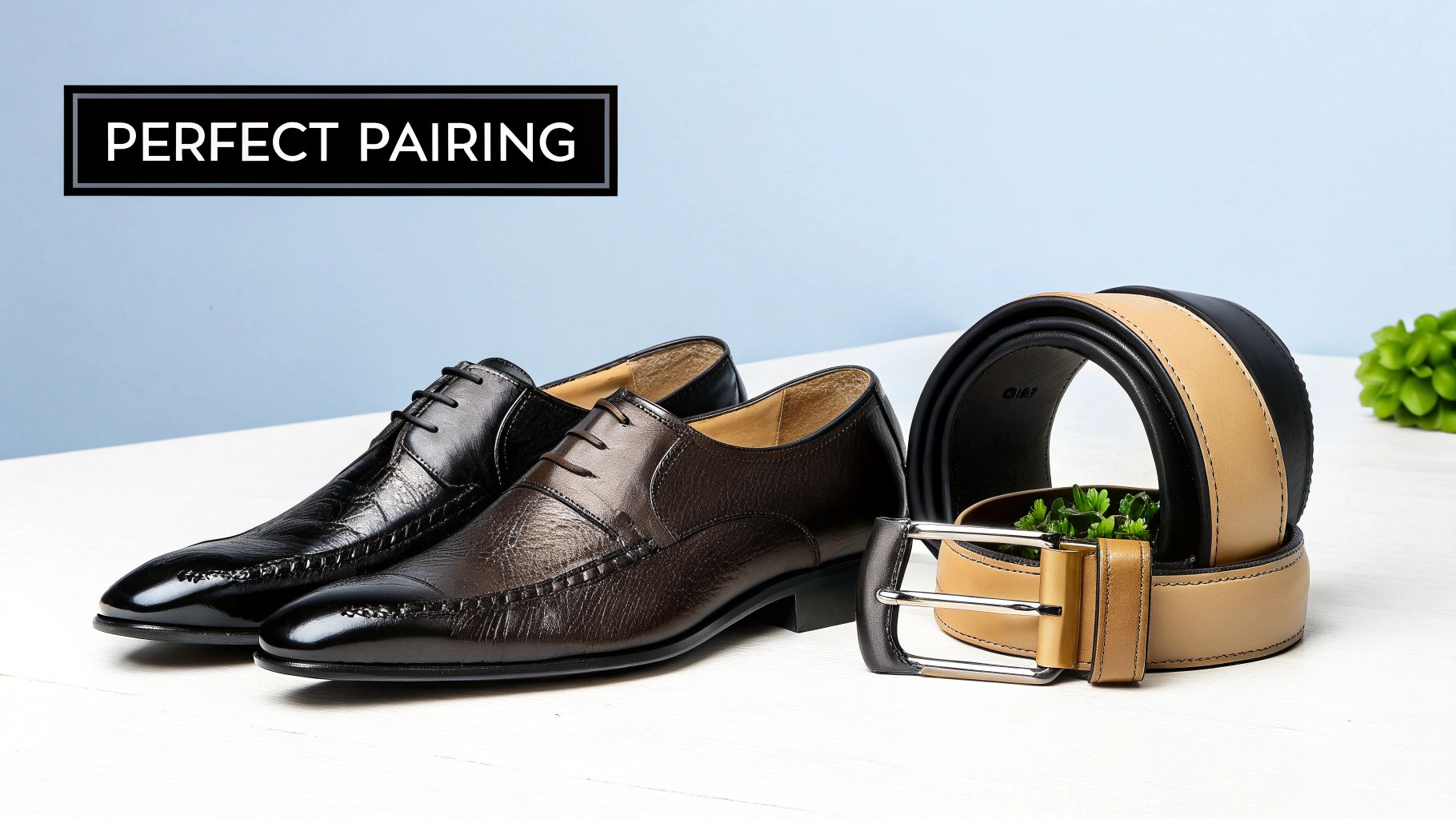
When an invitation calls for formalwear, the usual style "guidelines" become hard-and-fast rules. This is where precision matters most. A single mismatched detail can throw off an otherwise flawless look, so there’s absolutely no room for guesswork with your tuxedo or formal men's suit.
For the most elevated occasions—think a black-tie gala—the uniform is well-defined. If you’re in a classic black tuxedo, complete with satin peak lapels and a single-button closure, you need a slim, black patent leather belt and matching black patent leather shoes. The high-shine finish is essential. Choosing a matte leather, for example, would completely disrupt the polished, unified aesthetic that a well-constructed tuxedo demands. It's a non-negotiable detail.
Business Formal and Corporate Settings
In the world of corporate and business formal, your suit sets the standard. Whether you're in a sharp charcoal two-piece suit or a commanding navy three-piece suit, the most reliable choice will always be polished black calfskin Oxfords with a matching black leather belt. It's classic for a reason.
You have to pay attention to the little things:
- The Buckle: Your belt buckle should be simple and refined. A classic silver frame-style buckle is a great choice, as it won't clash with the hardware on a quality watch or the suit's buttons.
- The Finish: The sheen on your belt and shoes must be a perfect match. If your shoes are highly polished for your worsted wool business suit, your belt needs to have that same gloss.
This demand for perfectly coordinated, high-quality accessories is something we see reflected across the market. Men are increasingly seeking out classic designs to complete their formal looks.
Crucial Takeaway: For any formal outfit, from a tuxedo to a pinstripe three-piece suit, the texture and finish of your leathers are just as important as the color. Glossy patent leather shoes require a glossy patent leather belt. Polished calfskin shoes need a polished calfskin belt.
While black is the undisputed champion for business formal, there are some moments where you can bend the rules slightly. A rich, dark brown derby shoe can look fantastic with a navy or dark grey two-piece suit, but only in a less conservative corporate environment. Just make sure you have an equally rich, dark brown leather belt to maintain that visual harmony.
And if you’re deciding on the right tuxedo for an upcoming event, our guide on choosing between a white or black tuxedo can help you nail the perfect look.
Navigating Business Casual and Smart Casual
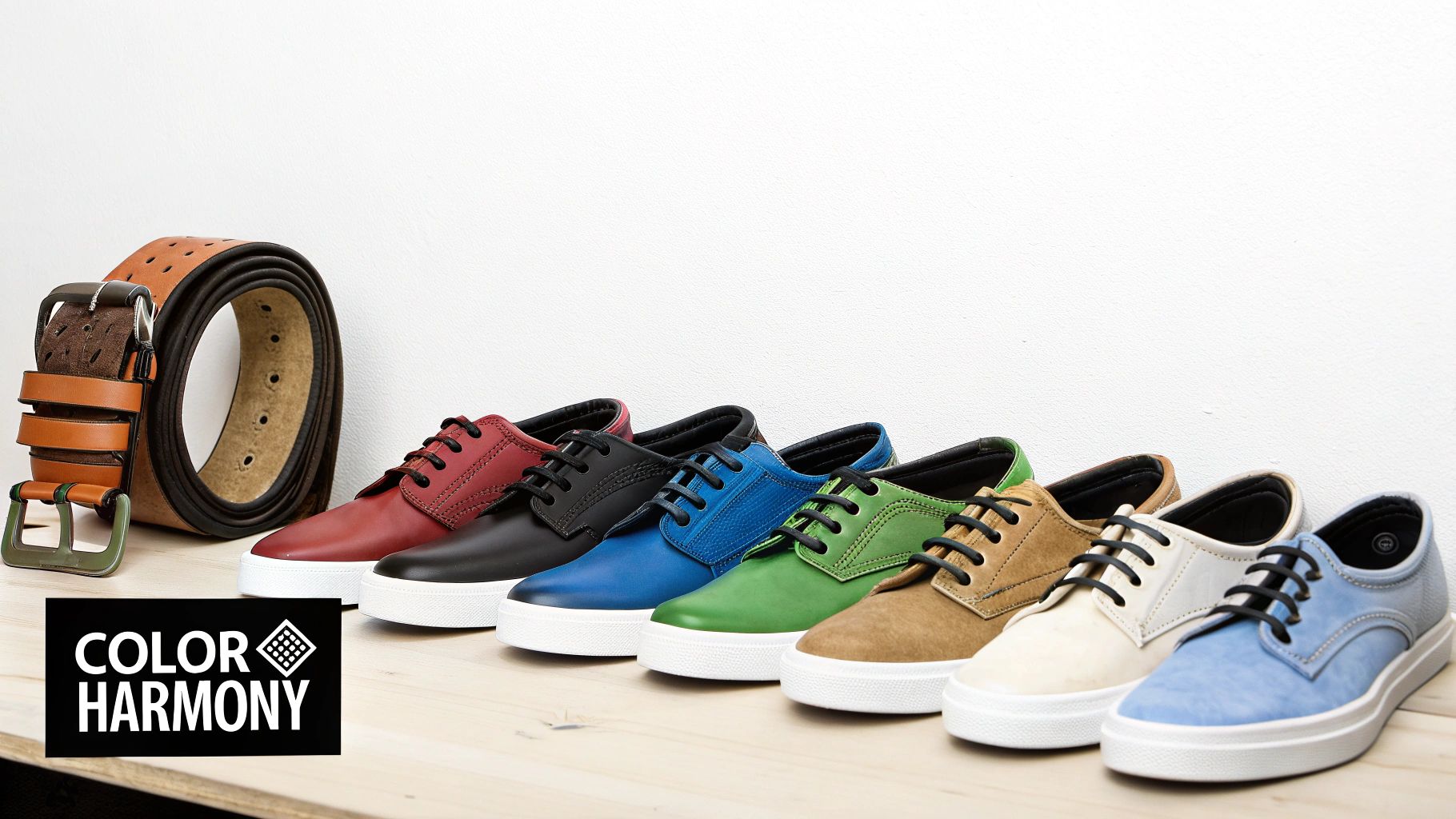
Once you step away from the rigid world of corporate dress codes, you enter the much more interesting territory of business casual and smart casual. This is your chance to show some personality, but the core principles of great coordination are still what hold your look together. The rules get a lot more flexible here, opening the door for creative pairings that still look sharp and deliberate, even with an unlined, soft-shouldered men's suit.
This is really where brown leather comes into its own. While black is the undisputed king of formalwear, brown offers a whole spectrum of tones and shades that are absolutely perfect for less buttoned-up settings. From a deep chocolate or rich cognac all the way to a light tan, the versatility you get with brown is incredible.
Think about a modern light grey two-piece suit—the kind with softer shoulders, a slim fit, and a more relaxed feel. Instead of automatically reaching for black, try pairing it with dark brown wingtip brogues and a perfectly matched dark brown belt. The whole look feels warmer and more contemporary, less severe than what you’d get with black.
Adding Texture and Character
Smart casual is also your invitation to start playing with different materials and textures. It’s a simple but incredibly effective way to add some real depth and interest to an outfit. This is what shows a more advanced understanding of style—it’s about moving beyond just color and thinking about the feel of your accessories when paired with a sport coat or a casual suit.
Let’s say you’re wearing navy chinos with a single-breasted sport coat. You can elevate this classic combination with a few key details:
- Suede Loafers: A pair of tan suede loafers introduces a soft, almost velvety texture.
- Woven Belt: Instead of flat leather, a woven tan leather belt complements the loafers perfectly. The texture in the belt creates a cohesive, relaxed vibe that just works.
This is the kind of pairing that makes a smart casual outfit really stand out. You’re matching the color, but you're also echoing the material's feel. Suede shoes almost always call for a suede belt; it’s one of those small details that makes a massive impact.
The real art of business casual is looking put-together without looking like you're trying too hard. When it comes to brown leathers with a casual two-piece suit or blazer, matching the shade and tone is far more important than a perfect, factory-matched set. A medium brown belt with a slightly lighter brown shoe can absolutely work, as long as the undertones feel right.
Ultimately, mastering this style is all about finding the right balance. You want to look thoughtful, not over-styled. By focusing on coordinating your brown leathers and introducing complementary textures, you can confidently pull together outfits that are perfect for the modern office or a stylish weekend out.
Creative Pairings for Casual and Weekend Wear
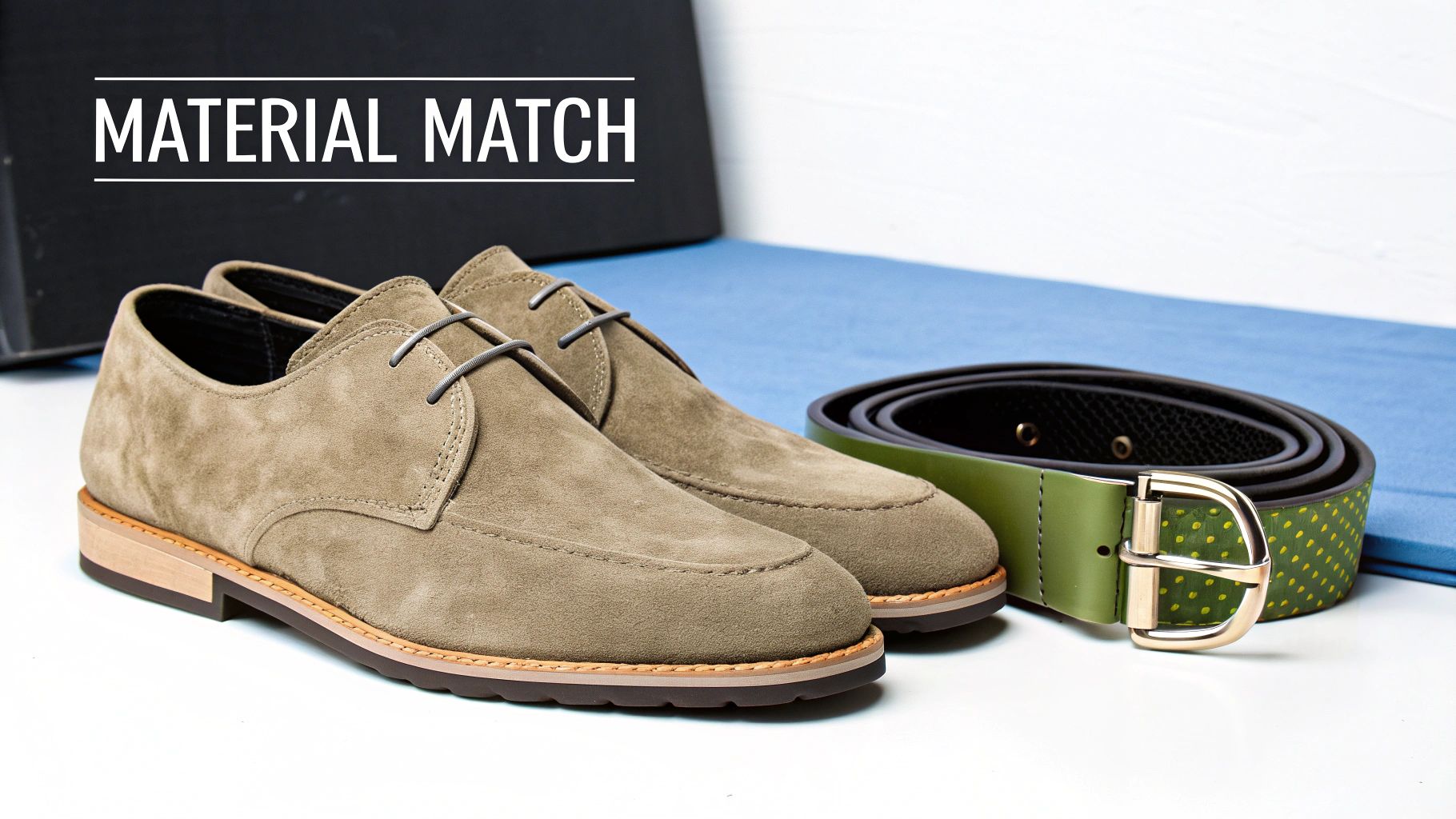
When the weekend hits, those strict rules of formalwear can finally take a backseat. This is your chance to get creative and inject some real personality into your outfits, especially when it comes to pairing your belt and shoes. We're talking denim, casual chinos, or even a breezy linen shirt—occasions where perfect uniformity gives way to thoughtful coordination. This isn't about matching accessories for a men's suit; it's about complementing your relaxed style.
Forget trying to find an exact match for your shoes. Instead of a polished leather belt that might feel too stiff, think about materials that vibe with the relaxed feel of your footwear.
- Fabric and Canvas Belts: These are a natural fit for canvas sneakers or classic boat shoes. A navy fabric belt paired with navy sneakers, for example, creates a cohesive look that feels intentional without the formality of leather.
- Braided Belts: A braided leather or cotton belt is all about adding texture. This casual detail works incredibly well with loafers or driving mocs, giving your outfit a more laid-back, considered feel.
The Art of the 'Close Enough' Match
For those more rugged looks, you can fully embrace what I call the "close enough" approach. A heavily distressed brown leather belt doesn't need to be a carbon copy of your well-worn leather boots. Not at all.
As long as they're in the same color family—think a chestnut brown belt with a pair of darker brown boots—the look feels authentic and intentional, not sloppy. It's about capturing a shared attitude, not matching a color swatch.
The most important rule for casual wear is to make your choices look deliberate. You can absolutely wear a navy belt to pick up a color from your shirt, or a burgundy belt to create a pop of color against neutral chinos. The key is making it look like a conscious style choice.
You can also think bigger and use your belt to complement the entire outfit, not just your shoes. A tan woven belt, for instance, might be the perfect piece to tie in with a khaki field jacket. In casual settings, your belt and shoes become part of a broader style conversation, giving you so much more room for creative expression. This is your opportunity to break the rules with confidence.
Go Beyond Color: Nail the Details with Texture and Hardware
Getting the color right is just the starting line. If you really want to elevate your style, you have to look at the finer details—specifically, the texture of your leathers and the finish of your metals. This is what separates a good outfit from a truly great one, whether you're styling a tuxedo or a casual suit.
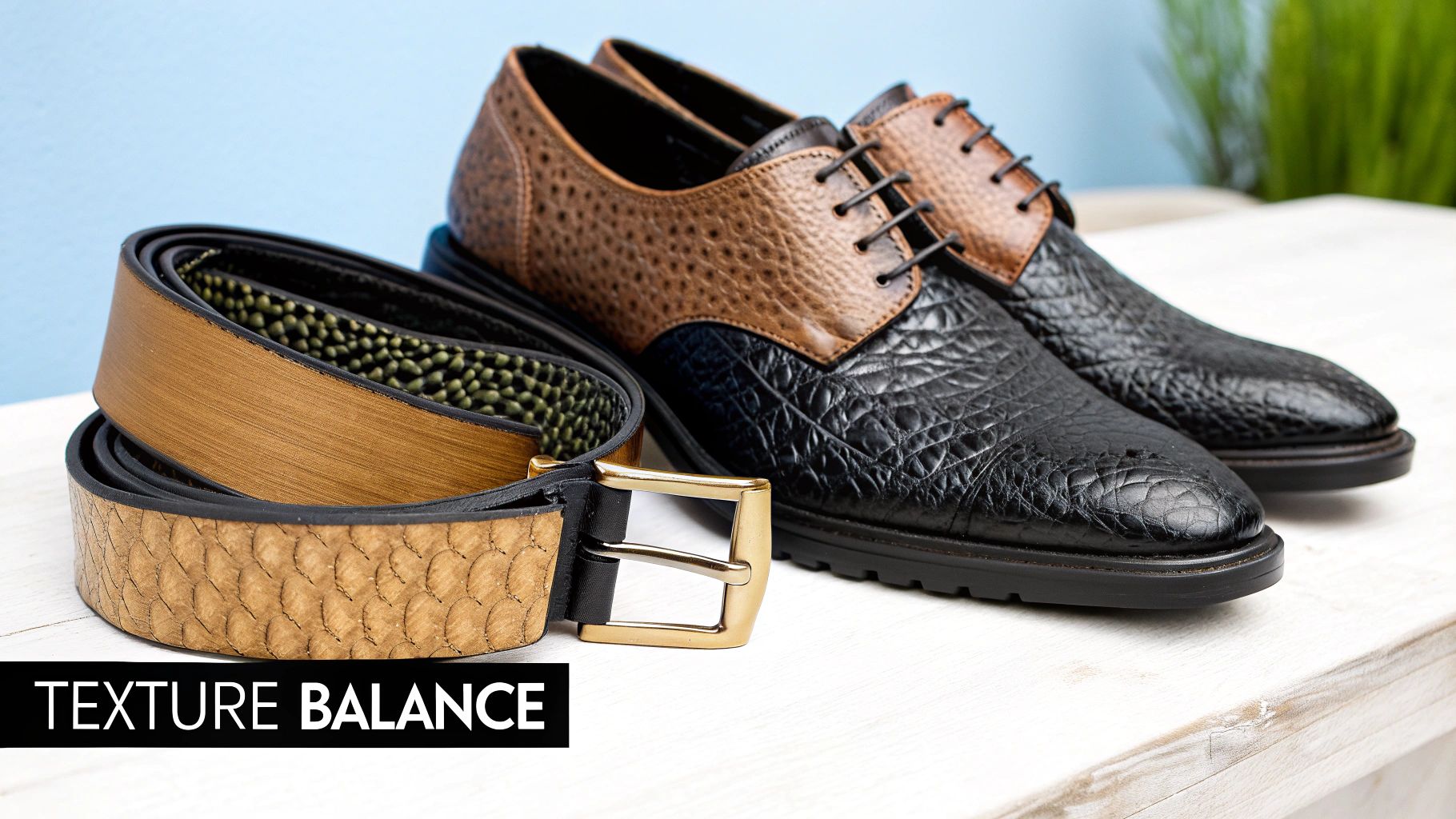
Think of it this way: your belt's finish should always complement your shoe's finish. A shiny patent leather belt, for example, is made for one thing and one thing only—equally glossy patent leather shoes. That's the go-to combo for formalwear, especially a classic black tuxedo with satin-faced lapels. On the flip side, a belt with a more natural, matte grain is the perfect partner for matte dress shoes or loafers, making it a solid choice for a business casual two-piece suit in flannel or tweed.
Aligning Textures and Metals
This same thinking applies to other materials and your metal hardware. When everything is in sync, you create a polished look that feels intentional and complete.
- Suede Loves Suede: Got a pair of suede chukka boots or loafers for your smart-casual three-piece suit? Don't even think about a flat leather belt. Grab a suede one instead. The consistent soft texture creates a sophisticated, thought-out look that's perfect for smart casual outfits.
- Hardware Harmony: The metal on your belt buckle needs to play nice with your other accessories. If you're wearing a steel watch and silver cufflinks with your French-cuffed shirt, a polished silver buckle is the obvious move. Rocking a watch with a gold case? You guessed it—a belt with a gold-tone buckle pulls the whole look together, especially if it complements the buttons on your suit jacket.
This kind of meticulous coordination signals that you've considered every last detail of your outfit. It’s that extra step that projects confidence and a real mastery of your personal style.
This growing focus on the finer points of style isn't just a niche trend. The global footwear market is expected to hit an incredible $592 billion by 2032, which means more guys are paying attention to the accessories that complete their look. As style evolves, so does the demand for belts and other items that perfectly match their shoes for every type of men's suit.
These details become even more critical when you're piecing together seasonal looks. For more inspiration on accessorizing, check out our guide on creating the perfect spring suit ensemble.
Your Questions on Matching Shoes and Belts Answered
We get a lot of questions about the finer points of pairing shoes and belts. Getting this combination right can feel tricky, but it's one of those details that really pulls an outfit together, from a formal tuxedo to a casual men's suit. Let's tackle some of the most common dilemmas you might face.
https://www.youtube.com/embed/EMXkFum1ApQ
Below are quick, real-world answers to help you nail your look with confidence every single time.
Do I Need an Exact Match for a Casual Suit?
Not necessarily. When you're dealing with a more laid-back men's suit—think an unstructured, unlined suit in cotton, linen, or a casual wool blend—you have more breathing room. Absolute precision isn't the goal here; looking intentional is.
The key is to keep the colors in the same family and general tone. For instance, a medium brown leather belt works perfectly with a pair of light brown suede loafers when wearing a light-colored summer suit. The textures are different, the shades aren't identical, but they clearly belong together.
What Belt Do I Wear with Canvas Sneakers?
This is a great question because it highlights how footwear dictates the formality of your accessories. A polished leather dress belt paired with casual sneakers like a classic pair of Chucks or Vans will look completely out of place. It creates a visual clash that undermines even a well-chosen casual outfit.
Instead, your belt should match the casual vibe of the shoes.
- A canvas or woven fabric belt is your best bet.
- You can either match the color directly (a navy canvas belt with navy sneakers) or use the belt as a subtle pop of color. It's all about maintaining a relaxed, cohesive look.
Can I Wear a Large Branded Buckle with a Suit?
I'm going to be direct here: please don't. A business suit, and especially a tuxedo, is built on a foundation of elegance and subtlety. The whole point is to create a sleek, uninterrupted silhouette that flatters your frame, from the jacket's tailored lining down to the hem of the trousers.
A large, flashy, or heavily branded buckle completely shatters that effect. It draws the eye right to your waist for all the wrong reasons and frankly, looks unprofessional when you're wearing a finely constructed two-piece or three-piece suit.
Stick to a classic, understated frame-style buckle. The metal should coordinate with your other accessories, like your watch, cufflinks, or even the suit's buttons. Save those big statement buckles for your most casual outfits with jeans and a t-shirt.
Ready to perfect every detail of your formal look? Explore the complete collection of premium suits, tuxedos, and accessories at VIOSSI to find the ideal pieces for your next event. Shop the collection now at viossi.com.


